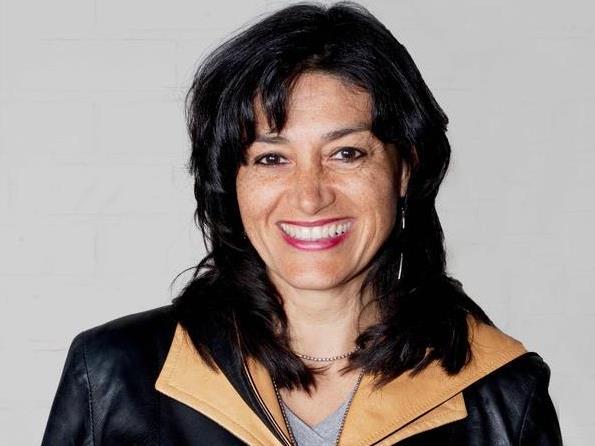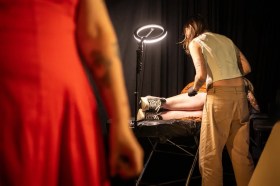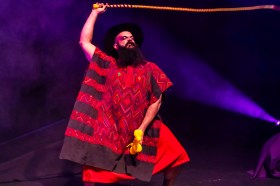Pilar Kasat. Photo credit: Jean-Paul Horré
As a woman of colour and one of very few in Australia who has had a seat at the arts and culture leadership table, not only did I have to work extremely hard, but I also had to culturally censor myself to ensure the multiple assumptions made of me did not define me. When the substance of one’s argument is continually superseded by the exoticism of one’s accent, and the opinions and critical thinking one exercises are construed as ‘passion’, you know you have to sharpen your tools. That is what I am doing now. I vacated a senior position in the arts to undertake a PhD.
The reality for women of colour is that, to be taken seriously as leaders, our competencies and capabilities need to be more developed and our educational levels have to be higher. At the same time our personal power needs to be masked, because we are seen as overly outspoken and our dress code policed, because we are seen as too flamboyant.
In the absence of opportunities, what do we do with our aspirations for leadership? What do we do with our intellect, readiness, skills, capacity, experience and insights? Does the recent signposting about the importance of diversity in the arts for Australia mean that the sector is ready for us? Or are these rumblings just more platitudes, a trend that will subside when the next pc craze arises?
The truth is that change doesn’t just happen. To shift from entrenched white normativity and cultural dominance towards true representation of diversity in all its manifestations needs at least two things. First, the prevalence of white privilege surrounding leadership in the arts needs to be acknowledged, and secondly, it needs to be dismantled. This is the work of leaders.
The truth is that change doesn’t just happen.
These conversations about diversity and the arts are not new. They are part of a long trajectory of attempting to establish a position and a platform from which to speak, to be heard and to exercise leadership in our own way. Despite this history, our complexities are routinely oversimplified by way of reductive labels such as Non-English Speaking Background (NESB) in the 1980s to Culturally and Linguistically Diverse (CALD) in the 1990s and now, apparently, we have become Black and Ethnic Minorities (BMEs).
Shaking these labels and everything they are loaded with is arduous, time consuming and ultimately exhausting. They do nothing to propel us forward into leadership. I eagerly await the Diversity Arts Australia (DAA) report that examines the state of diversity in the arts today. I know what this report will reveal. According to DAA’s Chair James Arvanitakis, at the Fair Play Symposium in Melbourne last month, the research behind this report has unsurprisingly ruffled feathers.
If the possibility of real change in the diversity space progresses as slow as the women’s battle for senior company positions – 80 years to become a CEO or to get paid the equivalent salary to a male senior executive, according to the Australian Workplace Gender Equity Agency – what are our chances of meaningful change as culturally diverse women leaders? I take this personally. For someone who has held and continues to aspire to a leadership position in our sector, then the questions about leadership really matter because I don’t have decades to wait.
We must accelerate the pace of change. We need tangible action and meaningful opportunities. We know that affirmative action and quotas work, so what about ensuring that diversity quotas are ambitious and clear across the subsidised arts and cultural sector, and that they are embedded systematically across arts boards, senior executives, artistic directors, programming, commissioning of new work? This, coupled with incentives to showcase diversity and to support the re-invention and reimagining of self-determined practice, is needed at this very uncertain time.
We know that affirmative action and quotas work, so what about ensuring that diversity quotas are ambitious and clear across the subsidised arts and cultural sector, and that they are embedded systematically?
The Australia Council Board is, by the measure of diversity, making greater strides than many of its funded organisations. However, our community today can’t wait decades for change, so the Australia Council must lead more powerfully on this issue. Diversity is good for business, so we look to the Council to use its influence and power in the sector to leverage this change through its 2020-2024 strategy which is currently out for public comment.
When it comes to leadership in the diversity space, not surprisingly, we see diverse women stepping up to the plate. This is where I have seen the most courageous leadership examples to date. Veronica Pardo, the CEO of Multicultural Arts Victoria is leading the charge. Last year, she vacated the position of Executive Director of Arts Access Victoria to make way for a woman with a disability to occupy the leadership role. Skilfully, Caroline Bowditch now fills that role.
What does Veronica Pardo tell us about leadership and diversity? She tells us that she is prepared to relinquish power to effect change, putting her actions where her principles lie. That is courageous, strategic and political, as much as it is an act of commitment and love, one than transcend one’s own interests. That is what I call principled leadership. A truly inspiring act against a backdrop of senior executive corruption, political ambition and self-serving egotism, most of which have one common denominator: privilege.
Besides some positive rhetoric and resource commitments to increase diversity in the arts from places like Creative Victoria, the development of diversity indicators by some state governments, or the astute appointment of Shelagh Magadza as the Executive Director of the Chamber of Arts and Culture in WA, there is little structural progress I can point to. At a time when we must stand united against racism and hate speech it is imperative we elevate the conversation about diversity, unity and cohesion, so that our diverse communities can be reflected at all levels of the arts.





